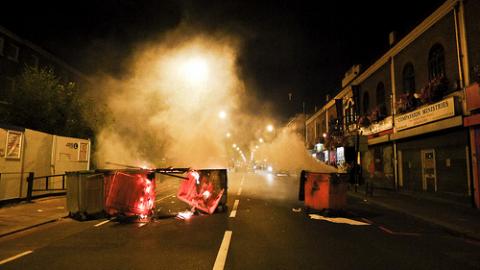Inequality and the English riots

The rioting in Britain was hardly unexpected, given the vast inequalities in British society. Ireland is no less unequal, meaning such social unrest is quite possible here, too. By Vincent Browne.
In itself, the scale of moral hypocrisy that the recent riots in Britain has prompted explains a lot about why the riots happened in the first place - and why similar social conflict may well happen here, again inflamed by our own propensity for moral hypocrisy.
David Cameron said in the House of Commons on Thursday that what was involved in those disturbances was ‘‘criminality, pure and simple’’.
Ed Miliband spoke in similar terms, as did multitudes of MPs from both sides, many of whom were exposed in recent times for massive expenses claims, some of them criminal, all of them probably costing British society far more than any damage done by any individual rioter.
Margaret Thatcher responded similarly to riots in 1981 in Tottenham and elsewhere, denying they had anything to do with unemployment and racism.
She was proved wrong by a subsequent investigation. It never occurred to her that there was anything odd about such behaviour being confined largely to the most deprived areas in Britain.
The Thatcher ideology was accepted almost in totality by the phenomenon known as New Labour.
A report published in January 2010 - An Anatomy of Economic Inequality in the UK, by the National Equality Panel and funded by the Government Equalities Office - stated, right at the beginning: ‘‘Britain is an unequal country, more so than many other industrial countries and more so than a generation ago’’.
It noted that Britain had the highest level of income inequality by 2007-08, more than at any time since the Second World War.
It stated: ‘‘For all employees ( in other words the average of all those in work) real earnings were roughly static between 2003 and 2008.
But between 1999 and 2007, the real earnings of CEOs of the top 100 companies almost doubled (reaching £2.4m a year) and those of the next 250 companies almost doubled (reaching £1.1m a year).
It reproduced an OECD chart on Gini coefficients of income inequality in OECD countries in the mid 2000s, which showed that of the 30 most developed countries, Britain rated 23rd (Ireland rated 21st ).
That OECD report found that the number of people living alone or in single-parent households increased in Britain more rapidly than in all other countries - and that there was less social mobility in Britain, the US and Italy than in Australia, Canada and Denmark, with parents’ earnings being a more reliable guide to a child’s future earnings.
So why is it that there was so much surprise at an outbreak of social unrest, given such inequality, infused with racism in society at large and particularly in the police force?
How is it that almost everyone who spoke in Westminster on Thursday ignored these social realities, which surely had some bearing on what had happened?
There are reasons to suspect there may be a similar outbreak of social unrest here.
Here, too, young people from deprived areas suffer from an absence of a stake in this society or any allegiance to it because of the deep inequalities that pertain here, resulting in the exclusion of a mass of people at the bottom from any real role in what is happening.
I have been hearing recently of stories emanating from a particular deprived area in the Dublin region, marked by serious poverty, lethal violence and intimidation, huge addiction problems and a sense of almost total alienation from what happens in society as a whole (I am not now in a position to be more specific). But it is possible to be specific about other area marked by deprivation, violence and intimidation: Moyross, St Mary’s Park and Southhill in Limerick city.
A superb study has been published recently on this subject: Understanding Limerick: Social Exclusion and Change, edited and mainly written by the UCC sociologist, Niamh Hourigan. It shows that, since 2002, Limerick city has ranked as the second most disadvantaged area, in socioeconomic terms, of the country’s 34 local authority areas.
In 2006, one of the electoral divisions in the city was the most disadvantaged of the entire country’s 3400 electoral districts.
The study also showed that Limerick was the most socially segregated of the four cities studied (the others being Galway, Waterford and Cork) with Limerick having the highest proportion of social housing in the state, at 42 per cent.
Hourigan’s book shows how the culture of fear was created and maintained, and how involvement in crime, allied to the criminal gangs, became the most logical option for disaffected young people, boys and girls.
For many young people, society offered almost nothing at all.
Their only access to respect and status came through criminality, by joining in the ‘‘hard man’’ culture, characterised by extreme violence and intimidation, and by association with the crime bosses. All this has since been made much worse by the cutbacks.
We have avoided social conflict of the kind experienced by Britain in the last week largely because of emigration - historically, we have exported our disillusioned youth to that country and to the US.
Now that option is very much less available and, if and when social conflict emerges here, we can foresee the reflexive law and order response and the rhetoric about criminality.
And this will be heard loudest from those who have spoken softly about the widespread criminality and social vandalism of the financial sector that has done far more harm to this country than a thousand hordes of disillusioned youths could ever hope to.
Image top: Nicobobinus.
